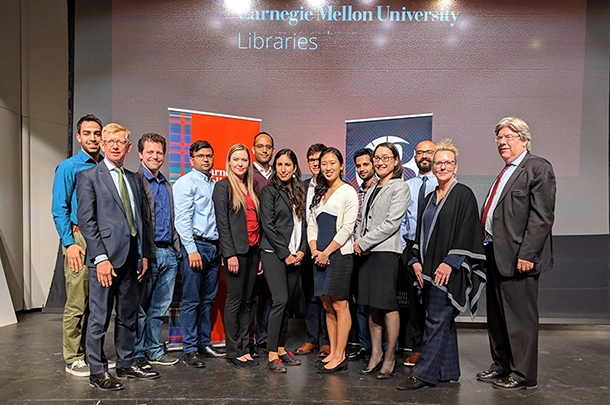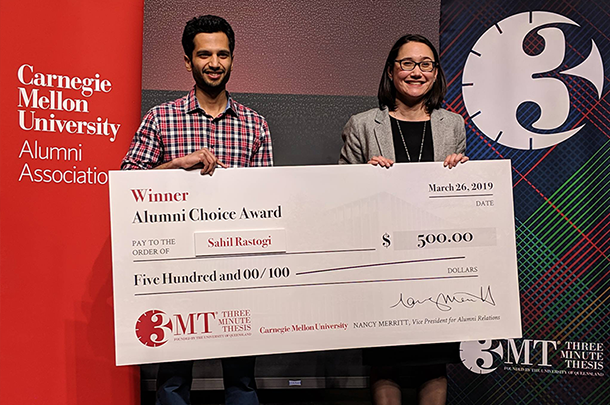Three minutes to win it
Eight doctoral candidates. Six from the College of Engineering. Three minutes each.
On Tuesday, March 26, Carnegie Mellon held its sixth annual Three Minute Thesis Championship. Founded by the University of Queensland, this competition happens at universities around the globe and challenges doctoral candidates to present their thesis—the culmination of years of research—in just three minutes.
Each year, competitors give their brief presentations to a non-specialist audience with nothing but a microphone, a clearly visible timer, and a single, non-animated digital slide or poster to serve as a visual aid. The judges grade each participant on their communication style, how easy it is to comprehend the work, and how engaging the presentation is. This challenges doctoral students to succinctly consolidate their work, rather than simply “dumbing it down,” and to develop presentation skills that they can use as professors, post-doctoral researchers, and in industry.
This year at Carnegie Mellon, students from the College of Engineering made up six of the eight competitors. Three competitors were from Biomedical Engineering (BME), two were from Mechanical Engineering (MechE), and one was from Chemical Engineering (ChemE).

Source: Carnegie Mellon University
Participants of the 2019 Three Minute Thesis competition
Dipanjan Saha from MechE kicked off the event by presenting his thesis, “Developing Superior Alloy Contacts to Enable Graphene Technology.” Graphene is a thin layer, smaller than a human hair’s width, made of carbon molecules in a sturdy hexagonal pattern. Its application to electronics could potentially result in better memory storage, new forms of sensors, and options for flexible, wearable tech. Saha researches the way in which graphene interacts with an alloy of carbon, nickel, and palladium. The molecular makeup of the alloy should have a fairly randomly distributed field of the three elements, but Saha has found that applying heat causes the palladium and nickel to separate into like groups. This discovery means that attaching graphene to this particular alloy could become easier with the simple addition of heat.
Sahil Rastogi from BME also discussed graphene in his presentation, “Graphene-based Multi-functional Nano-electronics to Study Brain.” Rastogi is interested particularly in graphene’s application to nano-devices that can monitor electrical and chemical signals from proteins in the brain. Being able to read this kind of activity could help predict the presence of neurological diseases such as Alzheimer’s and Parkinson’s.
Charles Sharkey from ChemE presented his thesis entitled, “Using Confined Bubble Flow to Construct Designer Foams.” The visual aid behind him showed tiny, oblong bubbles at a .58mm scale. Sharkey researches how processed liquids with suspended nanoparticles can form different kinds of bubbles that become coated in the nanoparticles, making them more rigid and less likely to pop. Changes in the liquid and to the speed of liquid extrusion through capillary tubes are variables that can be altered to affect the bubbles’ shape and rigidity. Producing foams from these kinds of bubbles can be used to create porous materials that weigh less than their non-porous equivalents.

Source: Carnegie Mellon University
Sahil Rastogi with the Alumni Choice Award prize
Prince Singh of MechE gave a presentation on his thesis, “Developing Materials for High Temperature Applications Aircraft Engines.” According to Singh, aircraft companies are the seventh largest polluter in the world, producing more emissions than entire countries. If engines could be made lighter, they would consume less fuel. However, due to the intense temperatures aircraft engines can reach (up to 1000 C or 1800 F), they are made of heavy metals that can take the heat. Singh is looking into a better approach, a nickel/tungsten alloy that is both lightweight and can take the heat.
Anna Kalmykov of BME presented her thesis, “Three-Dimensional Sensor Arrays to Study Human Mini-Hearts.” Looking to tackle cardiovascular disease and heart attacks, Kalmykov has been doing research into human mini-hearts. A mini-heart can be grown by taking a few cells from a patient and incubating them into an embryonic state that can be tested in labs. The results end up being similar to testing on a full human heart but without the same risks or expenses. In order to test the mini-hearts, Kalmykov develops 3D sensors that wrap around them, instead of using a traditional 2D sensor that only captures a tangent of the mini-hearts’ electrical activity.
Rachel Niu from BME finished off the evening with her thesis presentation, “What’s the FUS? A Noninvasive Method to Treat Neurological Disorders.” FUS stands for focused ultrasound stimulation, a method for activating key parts of the brain with pressure waves. Niu’s research focuses on how FUS works to treat neurological diseases like Alzheimer’s, Parkinson’s, and even depression. She also hopes to bring FUS out of laboratories and into personalized care systems that could be part of a patient’s daily routine, like brushing teeth.
The excellent performances by the College of Engineering participants garnered half of them awards for their efforts. Rastogi received the Alumni Choice Award based from online voting during the livestream. Saha took home the third place prize, and Niu received two awards: the People’s Choice Award, based on votes from the live audience, as well as second place overall.
